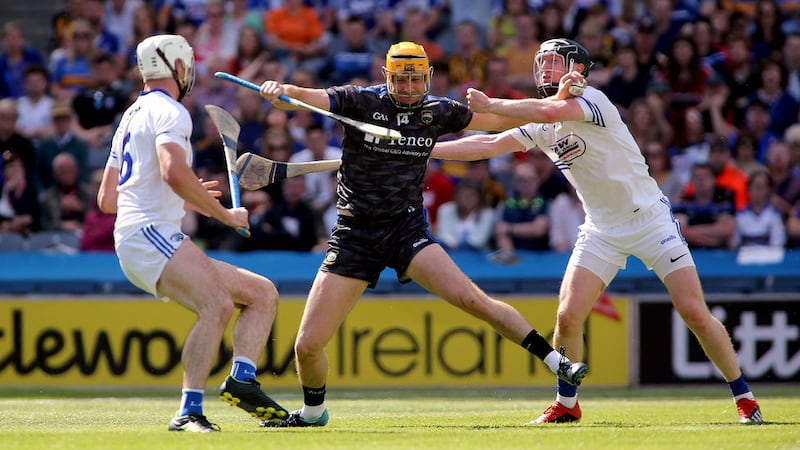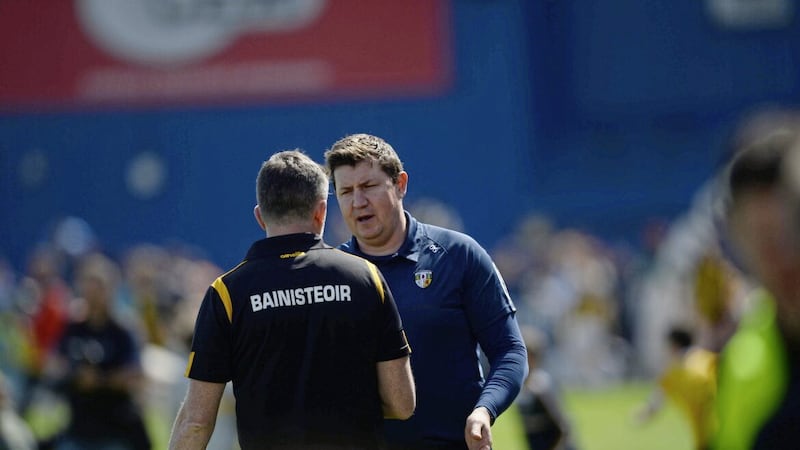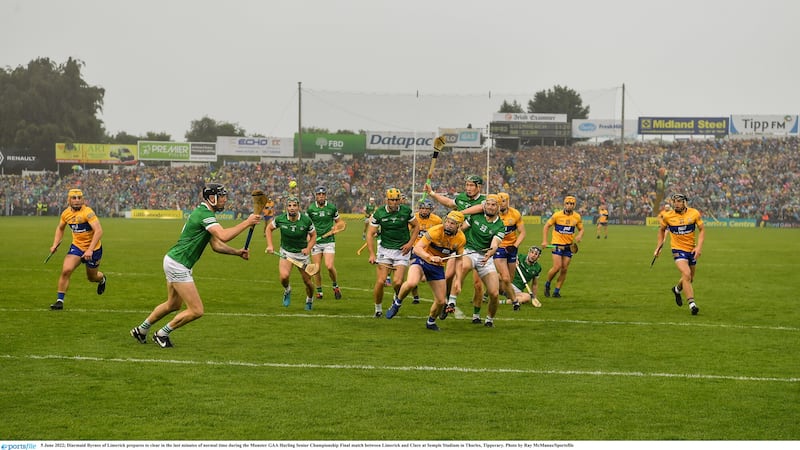NORMALLY, a controversial refereeing decision will provoke some amount of debate on both sides of the argument.
Whether it’s a black card, penalty or whatever, if it’s a big call, you’ll find plenty of people ready to argue the toss.
But not this week.
At the end of Saturday’s All-Ireland SHC semi-final, Darragh O’Donovan stood over a do-or-die sideline cut for Limerick, trailing by a point to Kilkenny.
He sent it towards goal but it flew over the endline, pretty obviously deflected by the jumping Cillian Buckley.
But referee Alan Kelly, his linesman and their umpires didn’t think so. It was signalled ‘wide’ and moments later Limerick had lost their All-Ireland crown.
Both live coverage teams on RTé and Sky agreed that it was clearly a 65. The same on The Sunday Game the following evening, the same everywhere – although some publications were adamant it should have been a ’65. Apparently when a team play the ball out over their own endline the other side are awarded the year Rubber Soul came out.
Anyway, misplaced apostrophes apart, it was obvious. Limerick should have been awarded a 65.
Except they shouldn’t.
They should have been awarded, to quote the Playing Rules of Hurling in the GAA Official Guide, “a free puck 13m more advantageous than the place of original puck – up to opponents’ 20m line”.
That’s because Buckley contravened Rule 4.19, that states it is a foul “to interfere with a player taking a free puck or sideline puck by jumping up and down, waving hands or hurley, or any other physical or verbal interference considered by the referee to be aimed at distracting the player taking the puck”.
You can stand and hold your hurley upright, but you can’t wave it around and you can’t jump.
Among all the reaction to the incident some mentioned that Buckley was too close to O’Donovan – which he was – but no-one, not even former referee Brian Gavin, writing in the Irish Examiner, noted his jumping as being illegal.
Donal Og Cusack (below) – when he wasn’t blaming Winston Churchill for refusing to play a two-man full-forward line or something – gave Buckley credit for his manoeuvre.
But it’s not really a surprise. When is the last time you saw a referee penalise a player for jumping in front of a free-taker? They have plenty of opportunities to do it because just about every time someone lines up to take a free an opposition player will stand in front of them and jump as they hit it.
I’ve seen it called twice, by the same referee in the same All-Ireland SHC match against the same player. On both occasions the re-awarded, easier free, which had been missed the first time, was scored the second time.
I won’t name names to protect the stupidity, sorry identity, of the player in question.
It’s not the only rule in the book that is literally never applied. Reader note: I’m using the modern definition of literally, which is to say, the opposite of what it actually means.
There are plenty of fouls, in both hurling and football, that we only see punished if we’re really lucky.
Rule 4.24
While we’re on the subject of sideline balls, you can’t “make a divot for the purpose of teeing up the ball for a free puck or sideline puck”.
The rulebook helpfully defines a divot as “an elevation formed from the surface of the pitch for the purpose of teeing up the ball on the ground”, which is exactly what all those players are trying to create when they paw at the grass before carefully placing the ball.
But unless you dig you heel into the sod or go at it with your stick like you’re footing turf, you’ll get away with it.
Rule 1.1 (ix)
One of the duties of the referee is “to order that all players are correctly attired in so far as this is required by Rule”. And yet those hideous Tipperary and Mayo away strips still see the light of day?
Rule 1.2 (vi)
The ref must also “record playing time, and to extend time in each half for deliberate or incidental delay…” Strangely no mention of allowing a team trailing by a point one more chance of getting an equaliser, even with time apparently, mysteriously expired.
Rule 1.5 (a)
“Play shall not be stopped for injury to a player, except in exceptional circumstances to enable a seriously injured player to be treated on the field or removed from the field of play. All other Injuries shall be treated off the field of play.”
Cramp = not serious. Anything a player can continue playing after = almost certainly not serious. Goalkeeper missing a contact lens = you cannot be serious.
Rule 1.7 (hurling); Rule 1.4 (football)
“When a player is in possession of the ball, it may be: (a) carried for a maximum of four consecutive steps or held in the hand(s) for no longer than the time needed to take four steps.”
Who do they think they’re kidding? We’ve got the point now in both hurling and football that no-one expects to see a play blown up after taking five steps with the ball. Maybe with the way the speed of the games has increased it’s taken for granted that in the time it used to take players to go four steps they can now take twice as many. It also seems to be the case that if you’ve got an opponent hanging off you you’ve got carte blanche to trundle along for as long as you want, especially if you’re heading for goal.
Whatever the reason, you need to be doing very well – or rather, very badly – to be called for steps in the modern games.
Rule 5-10-5.14 (football)
And, finally, with time quickly ticking down, that portion of the rules everyone loves to read about: the black card. What’s that? The ref’s blown it up? Thank God for that.








